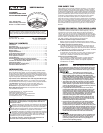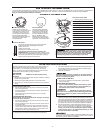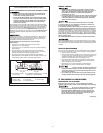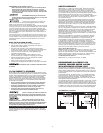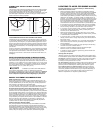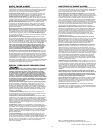
AGENCY PLACEMENT RECOMMENDATIONS
NFPA 72 (National Fire Code)
Smoke Alarms shall be installed in each separate sleeping room, out-
side each sleeping area in the immediate vicinity of the bedrooms and
on each additional story of the family living unit, including basements
and excluding crawl spaces and unfinished attics.
In new construction, Alarms shall be so arranged that operation of any
one Alarm shall cause the operation of all Alarms within the dwelling.
Smoke Detection-Are More Smoke Alarms Desirable? The required
number of Smoke Alarms might not provide reliable early warning
protection for those areas separated by a door from the areas protected
by the r
equired Smoke Alarms. For this reason, it is recommended that
the householder consider the use of additional Smoke Alarms for those
ar
eas for increased protection. The additional areas include the base-
ment, bedrooms, dining room, furnace room, utility room, and hallways
not pr
otected by the required Smoke Alarms. The installation of Smoke
Alarms in kitchens, attics (finished or unfinished), or garages is not
normally recommended, as these locations occasionally experience
conditions that can result in improper operation.
California State Fire Marshal (CSFM)
Early warning detection is best achieved by the installation of fire detec-
tion equipment in all r
ooms and areas of the household as follows: A
Smoke Alarm installed in each separate sleeping area (in the vicinity, but
outside bedrooms), and Heat or Smoke Alarms in the living rooms, dining
r
ooms, bedr
ooms, kitchens, hallways, finished attics, fur
nace r
ooms,
closets, utility and storage rooms, basements, and attached garages.
LOCATIONS TO AVOID FOR SMOKE ALARMS
F
or best performance, it is recommended you AVOID installing
S
moke Alarms in these areas:
•
Where combustion particles are produced. Combustion particles
form when something burns. Areas to avoid include poorly ventilated
k
itchens, garages, and furnace rooms. Keep units at least 20 feet
(6 meters) from the sources of combustion particles (stove, furnace,
water heater, space heater) if possible. In areas where a 20-foot (6 m)
d
istance is not possible – in modular, mobile, or smaller homes, for
example – it is recommended the Smoke Alarm be placed as far from
these fuel-burning sources as possible. The placement recommenda-
t
ions are intended to keep these Alarms at a reasonable distance
from a fuel-burning source, and thus reduce “unwanted” alarms.
Unwanted alarms can occur if a Smoke Alarm is placed directly next
t
o a fuel-burning source. Ventilate these areas as much as possible.
•
In air streams near kitchens. Air currents can draw cooking smoke
i
nto the sensing chamber of a Smoke Alarm near the kitchen.
•
In very damp, humid or steamy areas, or directly near bathrooms
with showers. Keep units at least 10 feet (3 meters) away from
s
howers, saunas, dishwashers, etc.
• Where the temperatures are regularly below 40˚ F (4˚C) or above
1
00˚ F (38˚C), including unheated buildings, outdoor rooms, porches,
or unfinished attics or basements.
•
In very dusty, dirty, or greasy areas. Do not install a Smoke Alarm
directly over the stove or range. Keep laundry room Smoke Alarms
f
ree of dust or lint.
•
Near fresh air vents, ceiling fans, or in very drafty areas. Drafts can
b
low smoke away from the unit, preventing it from reaching the
sensing chamber.
•
In insect infested areas. Insects can clog openings to the sensing
chamber and cause unwanted alarms.
• Less than 12 inches (305mm) away from fluorescent lights.
Electrical “noise” can interfere with the sensor.
• In “dead air” spaces. “Dead air” spaces may prevent smoke from
r
eaching the Smoke Alarm.
A
voiding Dead Air Spaces
“Dead air” spaces may prevent smoke fro
m reaching the Smoke Alarm.
To avoid dead air spaces, follow the installation recommendations below.
On ceilings, install Smoke Alarms as close to the center of the ceiling
as possible. If this is not possible, install the Smoke Alarm at least
4 inches (102 mm) from the wall or corner.
For wall mounting (if allowed by building codes), the top edge of Smoke
Alarms should be placed between 4 inches (102 mm) and 12 inches
(305 mm) from the wall/ceiling line, below typical “dead air” spaces.
On a peaked, gabled, or cathedral ceiling, install the first Smoke
Alarm within 3 feet (0.9 meters) of the peak of the ceiling, measured
horizontally. Additional Smoke Alarms may be required depending on
the length, angle, etc. of the ceiling's slope. Refer to NFPA 72 for
details on requirements for sloped or peaked ceilings.
5
INSTALLING SMOKE ALARMS IN MOBILE HOMES
For minimum security install one Smoke Alarm as close to each sleep-
ing area as possible. For more security, put one in each room. Many
older mobile homes (especially those built before 1978) have little or no
insulation. If your mobile home is not well insulated, or if you are unsure
of the amount of insulation, it is important to install units on inside walls
only. Smoke Alarms should be installed where temperatures normally
remain between 40˚ F (4˚ C) and 100˚ F (38˚ C).
This equipment should be installed in accordance with NFPA (National
Fire Protection Association) 72 and 101. National Fire Protection
Association, One Batterymarch Park, Quincy, MA 02269-9101.
Additional
local building and regulatory codes may apply in your area. Always
check compliance requirements before beginning any installation.
STROBE LIGHT OUTPUT FOR WALL & CEILING
MOUNTING
T
he intensity of the strobe light gradually lessens as the angle increases.
In other words, the light is brightest directly in front of the strobe light
a
nd is progressively less bright to either side. As required by
Underwriters Laboratories Inc. (UL), the following illustrations show how
the strobe light is dispersed. Use them to help you choose where to
l
ocate units for the hearing impaired.
P
HOTOSENSITIVE EPILEPSY AND STROBE FLASH RATES
I
ndividuals who are susceptible to photosensitive epilepsy might have
an incr
eased probability for seizures with multiple strobe lights flashing
a
synchronously. The frequency or speed of flashing light that is most
l
ikely to cause seizures varies from person to person. Generally, flashing
lights most likely to trigger seizures are between the frequency of 5 to
3
0 flashes per second (Hertz). This strobe light flashes at about 1 flash
p
er second.
Under the Americans with Disabilities Act, most workplaces and places
s
erving the public, including theaters, restaurants, and recreation areas,
a
re required to have fire alarms, which flash as well as ring so that
people who cannot hear or cannot hear well will know that there is an
e
mergency.
90 90
A
ngle
(In Degrees)
P
ercent
Light Intensity
0
5-25
3
0-45
50
5
5
6
0
65
70
7
5
8
0
8
5
9
0
100
90
7
5
55
4
5
4
0
35
35
3
0
3
0
2
5
2
5
45 45
0
9
0
9
0
4
5
45
0
W
ALL
L
IGHT
L
IGHT
CEILING
FIGURE 1:Light Output
for Ceiling Mount
F
IGURE 2:Light Output
for Wall Mount



